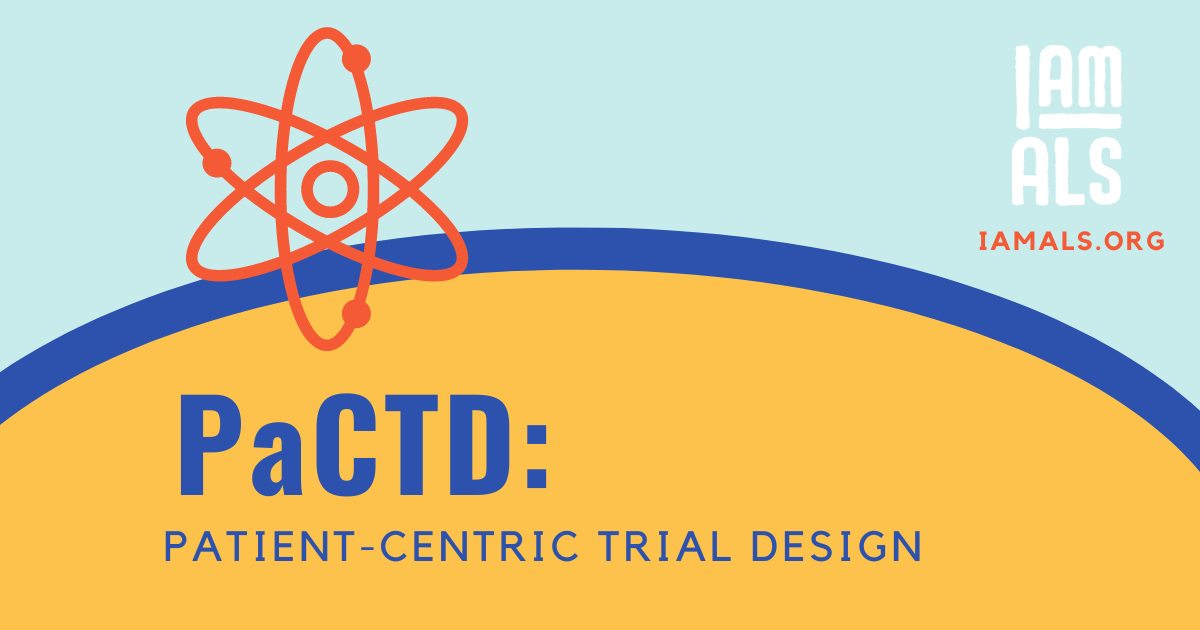The PaCTD rating system was created by a group of patient and caregiver volunteers on the I AM ALS Clinical Trials Team in 2020. It is in-line with the FDA’s ALS drug development guidance as outlined below. The goals of the rating system are to inform the ALS community about each clinical trial’s humaneness, accessibility and design efficiency, and highlight for drug developers the expectations of the community. The PaCTD ratings were updated in January 2025 to keep pace with changes in the ALS clinical trial landscape.
In general, the Clinical Trials Team will invite drug sponsors to discuss their late-stage clinical trial designs with the team prior to finalization. Team members will then individually rate the trial design prior to a team discussion where all ratings are discussed and a consensus developed. The consensus-based rating and rationale will be shared with the sponsor prior to publication.
Important Note: PaCTD ratings do not measure or evaluate the treatment’s safety or efficacy. A high rating on this scale does not indicate promising science and a low rating on this scale does not mean the treatment is ineffective — the ratings purely measure the design of the trial from the patient and caregiver perspective across the criteria outlined.
- What are PaCTD ratings?
- PaCTD Rating Helpful Definitions
- PaCTD Ratings for Individual Trials
PaCTD uses a 5-star rating system. The stars are awarded in three different categories described below.
What are PaCTD ratings?
Category 1: Optimizing patient access to investigational therapies (40%, 2 stars): This category addresses opportunities for individuals living with ALS to have increased access to investigational therapies. It is measured using two discreet categories each worth up to one star.
- Open-Label Extension: Provides an opportunity for all trial participants to continue on the active treatment after the blinded portion of the trial is completed regardless of whether they started on the active treatment or placebo. If offered the Open-Label Extension must be of meaningful design and duration.
- An Expanded Access Program: Provides an opportunity for individuals who are otherwise ineligible to participate in a clinical trial to receive access to the investigational therapy outside of the study.
Category 2: Advancing scientific progress (50%, 2½ stars). This category addresses whether a clinical trial incorporates design elements that may increase the chance of producing definitive trial results and advance the science of drug development in ALS. The following list provides examples but is not exhaustive. It uses non-discreet scoring.
- Consideration of disease heterogeneity in participation criteria or trial design.
- Optimized placebo ratio that addresses both access to investigational drug and statistical rigor
- Investigation of potentially regulatory grade biomarkers
- Independent unblinded review panel for interim efficacy check-ins
Category 3: Reducing patient burden (10%, ½ star). This category addresses whether a clinical trial uses all appropriate methods to reduce the burden on trial participants with ALS. The following list provides examples but is not exhaustive. It uses non-discreet scoring.
- Minimized run-in observation period
- Reduced travel burden
- Financial reimbursement for appropriate out of pocket costs
- Caregiver support
If you have any questions about this rating system, please contact community@iamals.org.
The PaCTD rating system is intended to be consistent with FDA ALS Clinical Trial Guidance Document which is referenced below as FDA). It can be found here.
Helpful Definitions
Open-Label Extension: The trial allows trial participants to continue to access the treatment after the participation commitment in the trial has ended through Open-Label Extension (FDA p.5).
An Expanded Access Program: The drug sponsor provides access for patients who do not meet trial inclusion/exclusion requirements through an Expanded Access Program (FDA p.4).
Minimize placebo usage: The clinical trial design seeks to minimize placebo administration to one-third of trial participants or less (FDA p.4 B1).
Consideration of disease heterogeneity: The trial utilizes novel design features to sort out the effects of disease heterogeneity (e.g. crossover design; delayed start design; re-randomization of outlier disease progressors as part of a post-trial subset analysis) (referred throughout the FDA guidance). For more on ALS disease heterogeneity, click here.
Use of scientifically justified eligibility criteria: All trial inclusion/exclusion requirements are scientifically justified and do not reflect a cut and paste attempt to copy prior unsuccessful trials (FDA p.3).
Investigation of biomarker: The trial attempts to identify and substantiate novel disease-related biomarkers (FDA p. 3 and 7).
Independent Unblinded Review Panel: The trial utilizes an Independent Unblinded Review Panel. This panel has the ability to halt a trial due to patient safety concerns. It also has the ability to identify early indicators of success so that there can be an adjustment to the trial to speed consideration of review (FDA p.3).
Use of minimal run-in observation period: The trial utilizes a run-in period of one month or less. A run-in period is a period of time between when a patient is accepted into a clinical trial and undergoes initial tests/screening and when the investigational drug/treatment is administered to a patient (FDA p.6 #3).
Reduce travel burden by use of novel methods: The trial design utilizes telemedicine, wearable technologies, financial reimbursement and/or other novel methods to limit patient travel and the number of clinic visits throughout the trial (FDA p.7).
PaCTD Ratings for Individual Trials
- Click to view a PaCTD Rating for current trials:
- Click to view a PaCTD Rating for non-enrolling trials:
- Alexion (Ultomiris)
- Apellis (Pegcetacoplan)
- Biogen (BIIB067 (SOD1)
- Brainstorm (NurOwn)
- Orphazyme (Arimoclomol)
- Healey Platform Trial (Regimen A, B and C)
- Clene Nanomedicine (CNM-Au8)
- Biohaven Pharmaceutical Holding Co (Verdiperstat)
- Ra Pharmaceuticals (Zilucoplan)
- Reldesemtiv (Cytokinetics Courage)
- Theracurmin
- Denali Therapeutics (DNL343-Healey Platform Regimen G)
- PTC Therapeutics (CARDINALS)

